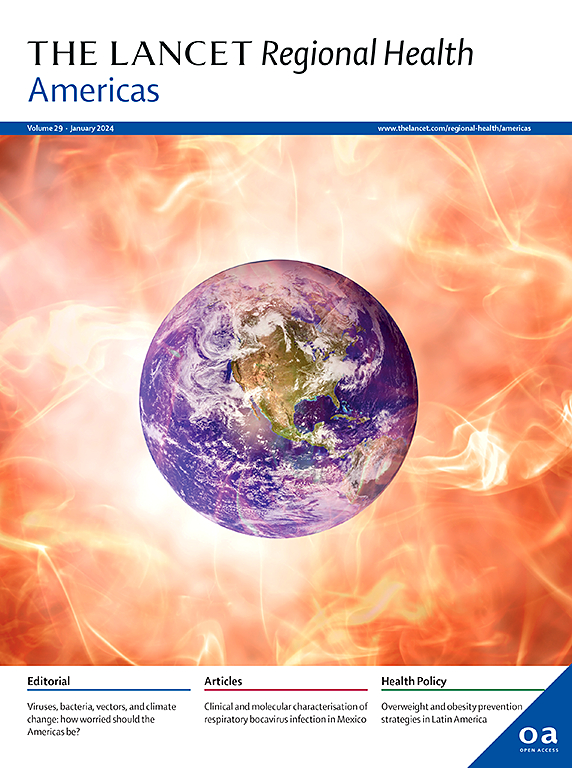In-person and media gun violence exposure in the United States: prevalence and disparities in a nationally representative, cross-sectional sample of adults
IF 7
Q1 HEALTH CARE SCIENCES & SERVICES
引用次数: 0
Abstract
Background
Knowledge remains limited about how people experience different types of exposure to gun violence. We analyzed the prevalence of in-person and media gun violence exposure (GVE) in a nationally representative sample of US adults.
Methods
Data were collected from 8009 US adults in May 2024, using design weights for representativeness. We measured in-person GVE, including direct (e.g., being shot) and indirect (e.g., hearing gunshots) exposures, along with frequency of exposure via traditional and social media. Exposures were analyzed by racial/ethnic group and household income. Multivariable associations were estimated using weighted multilevel mixed-effects regression models.
Findings
Significant racial/ethnic disparities in GVE were observed. Black Americans reported higher prevalence of all individual exposures (e.g., 38.5% of Black Americans [N = 337] know a family member or friend who has been shot vs. 25.53% of Hispanic Americans [N = 265] and 15.78% of White Americans [N = 849]), except firearm suicide. Black adults had higher media GVE, and neighborhood socioeconomic disadvantage was consistently linked to greater in-person exposure. Racial/ethnic disparities remained in multivariable models, including cumulative in-person exposure (Black beta [β] = 0.29, 95% CI: 0.17–0.41, p < 0.0001; Hispanic β = 0.13, 95% CI: 0.03–0.24, p = 0.018) and high media exposure (Black odds ratio [OR] = 1.57, 95% CI: 1.20–2.05, p = 0.001).
Interpretation
Nearly two-thirds of US adults have experienced in-person gun violence. Marked racial/ethnic disparities for both in-person and media GVE call for comprehensive strategies to reduce gun violence.
Funding
Authors are affiliated with the New Jersey Gun Violence Research Center, funded by the NJ Office of the Secretary of Higher Education.
美国的面对面和媒体枪支暴力暴露:在全国代表性的成年人横断面样本中的流行和差异
关于人们如何经历不同类型的枪支暴力的知识仍然有限。我们分析了美国成年人中具有全国代表性的面对面和媒体枪支暴力暴露(GVE)的流行程度。方法于2024年5月从8009名美国成年人中收集数据,采用设计权重作为代表性。我们测量了面对面的GVE,包括直接(例如,被枪击)和间接(例如,听到枪声)暴露,以及通过传统和社交媒体暴露的频率。暴露情况按种族/民族群体和家庭收入进行分析。使用加权多水平混合效应回归模型估计多变量关联。研究发现:GVE存在显著的种族/民族差异。除枪支自杀外,黑人在所有个体接触中都有较高的患病率(例如,38.5%的黑人[N = 337]知道有家庭成员或朋友被枪击,西班牙裔美国人[N = 265]为25.53%,白人美国人[N = 849]为15.78%)。黑人成年人有更高的媒体GVE,社区社会经济劣势一直与更多的面对面接触有关。种族/民族差异仍然存在于多变量模型中,包括累积的亲自暴露(Black beta [β] = 0.29, 95% CI: 0.17-0.41, p <;0.0001;西班牙裔β = 0.13, 95% CI: 0.03-0.24, p = 0.018)和高媒体暴露(黑人优势比[OR] = 1.57, 95% CI: 1.20-2.05, p = 0.001)。近三分之二的美国成年人亲身经历过枪支暴力。在现实生活和媒体中都存在明显的种族/民族差异,GVE呼吁采取全面的战略来减少枪支暴力。作者隶属于新泽西州枪支暴力研究中心,由新泽西州高等教育部长办公室资助。
本文章由计算机程序翻译,如有差异,请以英文原文为准。
求助全文
约1分钟内获得全文
求助全文
来源期刊

Lancet Regional Health-Americas
Multiple-
CiteScore
8.00
自引率
0.00%
发文量
0
期刊介绍:
The Lancet Regional Health – Americas, an open-access journal, contributes to The Lancet's global initiative by focusing on health-care quality and access in the Americas. It aims to advance clinical practice and health policy in the region, promoting better health outcomes. The journal publishes high-quality original research advocating change or shedding light on clinical practice and health policy. It welcomes submissions on various regional health topics, including infectious diseases, non-communicable diseases, child and adolescent health, maternal and reproductive health, emergency care, health policy, and health equity.
 求助内容:
求助内容: 应助结果提醒方式:
应助结果提醒方式:


